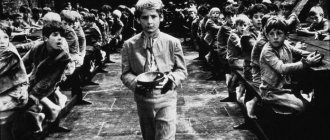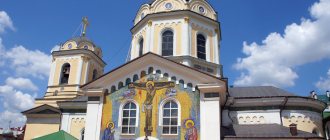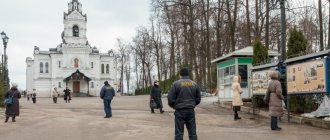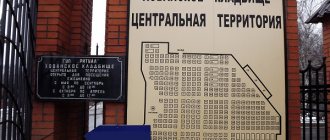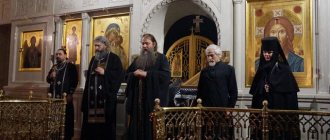Today, many people want to know what an almshouse is and what its purpose is. They take care of poor and sick people who cannot be cured for various reasons. People without a separate place of residence often come here and need a home and special care.
It is important to know the meaning of the word "almshouse". In such institutions, nurses work who prepare food, feed people with disabilities, and carry out daily hygiene procedures for bedridden patients.
Meaning of the word
Many people know what the word means, while others associate it with negative things.
This institution, which carries out charitable activities, provides assistance to disabled people who cannot care for themselves.
The meaning of the word almshouse is “for God’s sake.” Such institutions are often called charitable.
People staying in them can count on full care and comprehensive maintenance.
Note! Almshouses used to be called charitable institutions where they kept people who could not provide for themselves, take care of themselves and carry out daily chores.
In most cases, institutions assign disabled persons. These could be elderly people, infirm citizens, disabled people, cripples, patients who require rehabilitation after long-term treatment.
A person who ends up in such a charitable institution can count on full maintenance. Some institutions have been operating since ancient times.
Important! How the Nativity of St. Nicholas the Wonderworker is celebrated on August 11
The shelter house in Lublin was opened at the beginning of 1342, but even today it continues its activities, helping people who need help.
In Warsaw there is a house of the Holy Spirit and the Virgin Mary. It has been operating since 1388, and has already provided assistance to a huge number of elderly and needy people.
Almshouses in Moscow have several characteristic differences from poor houses and ancient Russian poor houses, so they should not be confused with each other.
Establishments at the monastery
In Russia today there are several dozen charitable institutions operating at monasteries. Those interested can buy a new book, which was published by the Synodal Department on Church Charity and Social Activities.
Interesting! Address of the Conception Monastery and schedule of services
Each nursing home has its own differences: resources, capabilities, type of premises. Some of them are located in city apartments, but at the same time they act on behalf of a specific monastery.
Separate premises are also being built to help elderly people. Particular attention must be paid to the type of activity, because in some homes residents may only be offered care, treatment or rehabilitation.
In the city of Ryazan there is a gerontological clinic, which operates under the patronage of the holy monastery.
Parishioners and volunteers help socially vulnerable and frail people who need care.
Funding comes from the municipal budget. They helped a huge number of people who quickly recovered after long-term treatment.
This is interesting! What is prayer by agreement: when and how to pray correctly
Frail people purchased a second home and were able to live their lives in care and love.
Wikipedia offers its own interpretation of the concept of almshouse. This is any charitable institution that helps disabled people: the elderly, the infirm, the disabled, the crippled or recovering citizens who have undergone long-term treatment and have no relatives.
In Russia, Christians began to open such establishments. In Ancient Rus', near every church there was a home for the elderly. Entire settlements of beggars formed near the monastery. The church accepted every person who asked for help. In those days, such establishments were maintained at the expense of the royal treasury.
It all started with Peter
Mercy and charity were encouraged, and sometimes even initiated, by the Russian authorities. Peter I in 1701 ordered the establishment of 60 almshouses near parish churches, and in 1718 the tsar forbade giving alms to people, demanding that aid be distributed through almshouses.
Article on the topic
The history of one commune: what is the Narkomfin House famous for? There were special shelters for illegitimate and street children.
One of them is an orphanage (Moskvoretskaya embankment, 5/9) ➊, built on the banks of the Moscow River by Karl Blank in the second half of the 18th century, and was the largest in Europe. It was intended for orphans, foundlings and street children. Catherine II herself contributed 100 thousand rubles. and annually added 50 thousand. But the wise empress managed to organize a “competition” between her associates in such a way that Prokofy Demidov (200 thousand rubles of personal money), even in the ceremonial portrait of D. Levitsky depicted against the background of an orphanage. Ivan Betskoy was not far behind Demidov (he distributed more than 160 thousand rubles). It is known how during the days of the occupation of Moscow by Napoleon, the chief caretaker of the house, Ivan Tutolmin , managed to place French wounded in the establishment entrusted to him, thanks to which 13 French gendarmes guarded the house from fire. In the entire area he was the only one who survived.
Article on the topic
Monument to the love of the count and the serf actress.
How Sklif was created Count Nikolai Sheremetev, in memory of his deceased wife, the famous Praskovya Kovaleva-Zhemchugova (AiF talked about their novel in No. 26 of 2011, see “Deadly Ostankino”), built a hospice house (B. Sukharevskaya pl., 3) ➋ to alleviate the lot of those suffering.
The count spent an incredible amount on this project - 3 million rubles. 140 people found shelter and care in the majestic mansion, built according to the design of Sheremetev’s friend and like-minded architect Giacomo Quarenghi. Over a hundred years, 6 million rubles were spent on the existence of the hospice house, and over two million people benefited from its benefits. Today, the former Sheremetevsk Hospital has turned into Sklif - Institute of Emergency Medicine named after. Sklifosovsky, one of the leading medical institutions in the country. Already in the 19th century. wife Maria Alexandrovna founded the Society for the Care of Wounded and Sick Soldiers. The initiative of the monarchs was first taken up by noble noble families, and later by merchant families.
For elderly war veterans, deprived of any benefits from the treasury, the Nikolaev almshouse was built at the expense of honorary citizen Fyodor Gorshkov , later renamed the Izmailovsky Invalid Home (Izmailovsky Ave., 4) ➌.
And on Strastnoy Boulevard, a monument to classicism and Moscow charity - the building of the Novo-Ekaterininskaya Hospital (Strostnoy Boulevard, 15/29) - has been empty for a long time, at the risk of its physical existence. Initially, it was intended for prisoners and unskilled workers, and after the hospital came under the jurisdiction of the city, it began to accept everyone.
How to get
A huge number of people are interested in how to get into such a house. According to the charter, many charitable organizations take into the care of Orthodox believers who are mentally healthy. Priests and service personnel work on the territory.
Often such organizations are attached to a hospital, so people in need can receive help from a therapist, psychiatrist, and other specialists.
Informative! Antarctica: Church of the Holy Trinity in Antarctica
This is a special form of social protection for elderly citizens.
To get into the almshouse, you need to go to the church and fill out a request form. Visiting service employees make calls to possible candidates. Additionally, all issues are discussed, and the person receives legal advice.
Employees must make sure that the citizen really needs help, long-term rehabilitation and support.
Not only older people can go to the almshouse.
People often ask for help:
- those in need who have no loved ones or whose relatives do not take them into care for various reasons;
- people who have been injured but need rehabilitation;
- old people without housing;
- homeless people.
It is these categories of citizens who need special care and guardianship.
Almshouse. As it is
There are almost none of them in our country, less than forty. And one of them is unique. She is located... in an ordinary Moscow apartment.
Grandmother Vera Nikolaevna lived in the 1st city hospital. She lived. There was nowhere to discharge her, the house was being demolished, she would simply end up on the street. She was kept at the mercy of the hospital; she also had no relatives. Very often such grandmothers appeared in the First City. Father Arkady Shatov, rector of the hospital church, thought about creating an almshouse.
After a four-room apartment on Shabolovka was donated to the temple, the problem began to be solved. On the eve of 2000, Vera Nikolaevna was brought here, then almost immediately another monk appeared (that’s what those living in the almshouse are called). They were cared for by the sisters of mercy of the St. Demetrius Sisterhood.
By that time, they had already been working in foster care for 10 years, going from house to house, helping grandparents. But with seriously ill patients it was necessary to spend almost 24 hours a day. The infirm became the first inhabitants. The almshouse gradually grew to accommodate six people. Four years later, the temple purchased a second apartment on the floor above with donations. This is how the St. Spiridonian almshouse appeared.
Now there are 12 inhabitants, 10 grandmothers, a grandfather and a paralyzed man of forty years old, all heavy and bedridden. They require professional care: look after bedsores, carry out medical appointments, and provide hygienic care. People who are bedridden cannot eat, wash, or go to the toilet themselves. And since each person does all this several times a day, the sisters are busy from morning to evening. Wet cleaning of all premises also falls on them.
Fifteen permanent sisters work at the almshouse, and about ten more people come as volunteers. In one of the apartments there is a chef, he cooks on two floors. There is a laundry room in the other kitchen.
The shift starts at 8 am. The sisters arrive a little earlier to change clothes and take care of business with the night sister. She tells how they felt, what pills were given, and whether there were any emergencies. In the same way, day nurses convey to night nurses what happened during the day, what new assignments and corrections were made.
Morning toilet, washing, changing clothes, changing diapers, sitting down for breakfast. Almost everyone can sit, but not for long. They get tired quickly. Igor Igorevich is transferred to a chair and brought to a table, the rest are sitting at the bedside.
Then hygiene procedures and medical appointments. Some get a drip, some get an injection.
They are trying to somehow activate the inhabitants. The more active a person is, the longer he lives and the easier it is for the sisters to deal with him. The sisters do not have the opportunity to take residents outside; they only walk with volunteers or friends. This is always a great joy and event for them, but it happens very rarely.
If one person comes to visit, then the resident is put in a stroller and two sisters, throwing the belts used by the movers over themselves and the stroller, go down the stairs with the guest. Exactly the same way back. If there are no men, four of them pull together. Somehow they tried to do something to equip a ramp, but it didn’t end in anything. We bought folding rails, but it was impossible to get the patients up and down - the stairs were steep, and they were afraid to drop them.
Therefore, the sisters try to make the monks sit at least longer. They listened to something, or, if they could, read, leafed through albums with photographs. Volodya and Igor Igorevich are sitting on the computer, Zoya Mikhailovna is listening to music or watching movies. Everyone is weak, but as much as possible, they are occupied with something.
After lunch, sleep and afternoon snack. And in the evening, again changing diapers, washing, changing clothes and evening appointments.
It is difficult to combine such work with anything else. Physically, caring for patients is very difficult. Grandmothers weigh 80 kilograms; to wash them, you need to turn them over in bed.
Once a week, each of the residents has a bath day. He is transferred from the bed to a chair and taken to the bathroom, which has a special drain in the floor. This procedure is the most difficult and it happens to someone every day. Undressing, picking him up in his arms, moving him to a chair - all this is done by one sister, it’s awkward for two people. In the bathroom - cutting nails and treating problem areas. At this time, another sister changes the bed linen and washes the bed with a special solution. At this point, the already washed grandmother is brought in.
Sometimes it happens that the second sister doesn’t have time, someone peed on her and crap herself. Then the first one must make a clean bed herself and change the grandmother. All this must be done quickly; old people get tired of all these manipulations.
This is a lot of physical stress; after the change of strength, you can’t cope with anything. If a sister works two days later, then on the first day she comes to her senses, and on the second she can already do something.
It is unrealistic to combine this work with some other work. All the sisters work only in the almshouse. Salaries are small - 130 rubles per hour. But they don’t work here for the money.
After a ten-month course, Victoria spent some time as a foster nurse. The work turned out to be too hard for her. But she couldn’t leave completely; she stayed in the laundry as a volunteer.
Everyone's diagnosis is different. Yulia Gavrilovna had a stroke. Raisa Ivanovna had a stroke, a broken arm, a leg, and craniotomy after a tumor. She can more or less move one arm and can lean on one leg. Due to this, it can be dragged; it weighs 160 kilograms. If it weren't for the leg, it would have been impossible to lift it at all.
Zoya Mikhailovna has a whole bunch of diseases, this is already a weakness. She can’t even sit for long, she collapses and is covered with pillows. Until recently, she could barely eat on her own, but now her sisters feed her.
Volodya is the youngest, he is 44 years old. He has a fracture of the cervical vertebrae, nothing moves below the chest. But, fortunately, he can somehow move with one hand and press the mouse with one finger. His whole life is on the Internet, he is paid for by an almshouse. Volodya only reads; he can’t type on the keyboard.
Alexandra Vasilyevna was the liveliest, she could go out into the street with a walker, accompanied by two sisters. But now she has weakened. Over time, everyone turns into bedridden people.
Igor Igorevich has weakness, contracture, and can’t support his legs. The deviations began headlong. It is very difficult to work with older people. They believe that they have worked their lives and now have the right to whims. Senile dementia (dementia) is also beginning.
The sister approaches the grandmother, and she tells her: “Don’t touch me, everyone leave. I don’t want anything, I won’t do anything!” But you need to take a shower, wash your face, get dressed, and have breakfast. The sisters turn on their imagination, invent some stories, try to switch attention: “Come on, please. Do you know who will come to us today?” And while chatting, they quietly get things done.
Sometimes patients quarrel among themselves. But you can’t resettle them. Those who are in their right mind understand the hopelessness of the situation and resign themselves. This is not a hospital where you can return home after two or three months. Everyone here knows that they will stay here until the end of their days. The sisters try to organize some small joys: holidays, birthdays, a concert for Christmas, and sometimes they prepare performances.
They don't watch TV in the almshouse. He stayed in only one of the rooms. Raisa Ivanovna, for example, took all the news to heart and was very worried. Senile dementia worsened the situation; she began to misinterpret them, retelling some nightmares. And the TV was taken away under the pretext that it was broken. She forgot about him. They found a replacement for him - Raisa Ivanovna loves to listen to songs by Soviet composers Ruslanova, Magomayev, Tolkunova.
And her neighbor, Yulia Gavrilovna, is almost deaf. She was once a teacher of English and German. She loved to read, but then she began to go blind. This became a tragedy for her, she lost what she could live on. But one of the sisters thought of putting headphones on her, she can still hear through them. Now from morning to evening Yulia Gavrilovna listens to audiobooks and no one bothers anyone.
No one gets here from a good life. These are always very difficult cases that can be reported by leaving a statement at the temple of Tsarevich Demetrius behind a candle box. The elder sister Olga Gennadievna and the doctor Margarita Vitalievna go from house to house and look at the situation. First of all, they take away those who simply die in the most hopeless cases. They talk to the rest, some of them themselves realize that the situation with their relative is not as critical as that of others. For them, the option of home patronage remains. Forty sisters come to such helpless people in the morning and leave in the evening. They do everything: feed, care, carry out hygiene procedures and carry out medical appointments.
There is almost always a queue at the almshouse. But while waiting, anything can happen; we are all not eternal. It happens that a grandmother dies, a place opens up, but there is no line. Someone has already died, someone has been added...
The St. Spiridonian almshouse is one of 24 projects of the Orthodox relief service “Mercy”, it exists on donations from caring people.
Nursing homes in Moscow
Due to the fact that in ancient times the church took into the care of people who feigned poverty, a separate law was passed.
At the Council of the Stoglavy, the tsar ordered that only real beggars be singled out. To do this, they carried out a census of all guests and arranged a separation of women's and men's charitable institutions.
Such people were supported with money they received from alms.
During the era of Catherine and Peter the Great, these were large places where employees could solve any social problems.
Interesting! Information about the Church of the Holy Spirit in Krasnodar
Gradually, the marginalized sections of society began to increase, so activities were suspended. The authorities became interested in supporting such institutions, so they began to actively allocate funds for charity.
When the city and Zemstvo reforms were adopted, local government was involved in sponsorship. New organizations began to actively open, whose task was to solve pressing social problems.
The main goal is the eradication of poverty. Patronage was ultimately divided between royal families, monasteries, and public organizations. At the beginning of the 20th century, charitable institutions were actively built.
Important! According to statistical data, in Moscow in 1990, more than 10 thousand people were kept under guardianship.
The establishments were located in different areas of the capital. The most famous and active organizations are Andreevskaya and Pokrovskaya.
At that time, there were other institutions that people could turn to for help:
- for caregivers;
- merchant clerks;
- sisters of mercy;
- military people;
- persons who have a clergy title.
A few centuries ago, people could write a petition to be assigned to an institution called the Nikolaev Izmailovskaya military almshouse, which was actively developing and carrying out its activities and had a rich history.
Its construction began in 1814. Nicholas was the first to make such a decision in order to provide and give protection to people who do not have income and need urgent assistance.
The territory of the former royal residence had a sad appearance. Here one could see cut down and neglected groves, dried up springs, lakes, and destroyed bridges.
The project was ignored, so it was decided to suspend construction work. Active construction of the building began closer to 1840. During this period, an official decree was issued.
The almshouse was planned to be made for retired soldiers and officers who, due to their age, had completed their service. People who spend most of their lives in military service, after dismissal, as a rule, did not have a home, property or means of food.
The first residents of the almshouse were veterans who took part in the Caucasian War. People who served in the Semenovsky and Preobrazhensky regiments were also provided with support. The territory was small, a small number of workers worked here, so only 20 officers and about 450 soldiers could be received.
Ten years later, the second building of the almshouse was opened. People were able to receive free treatment and food.
They did not have to pay for uniforms or accommodation on the charity's premises. Additionally, they were provided with a pension.
Leaders cared about their students. The territory was improved, trees, shrubs, and flowers were planted.
The water in the ponds was purified, and greens and natural vegetables were given for lunch and dinner. There was a cemetery nearby.
Now the almshouse building is partially destroyed. The Moscow metro station “Izmailovskaya” is located nearby. In 1918, this institution was no longer funded.
Now elderly and needy people can find employment in other institutions. The bathhouse, workshop, office, and officers' building have survived to this day. Since 2007, the building has been considered a museum-reserve. Now this is the cultural heritage of the capital.
